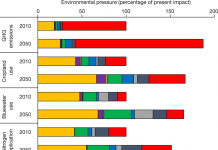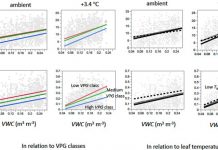【植物耐盐性的细胞机制】Caifu Jiang Eric J. Belfield Yi Cao J. Andrew C. Smith and Nicholas P. Harberd. An Arabidopsis Soil-Salinity–Tolerance Mutation Confers Ethylene-Mediated Enhancement of Sodium-Potassium Homeostasis. The Plant Cell September 2013 vol. 25 no. 9 3535-3552
Abstract
High soil Na concentrations damage plants by increasing cellular Na accumulation and K loss. Excess soil Na stimulates ethylene-induced soil-salinity tolerance the mechanism of which we here define via characterization of an Arabidopsis thaliana mutant displaying transpiration-dependent soil-salinity tolerance. This phenotype is conferred by a loss-of-function allele of ETHYLENE OVERPRODUCER1 (ETO1; mutant alleles of which cause increased production of ethylene). We show that lack of ETO1 function confers soil-salinity tolerance through improved shoot Na-K homeostasis effected via the ETHYLENE RESISTANT1–CONSTITUTIVE TRIPLE RESPONSE1 ethylene signaling pathway. Under transpiring conditions lack of ETO1 function reduces root Na influx and both stelar and xylem sap Na concentrations thereby restricting root-to-shoot delivery of Na. These effects are associated with increased accumulation of RESPIRATORY BURST OXIDASE HOMOLOG F (RBOHF)–dependent reactive oxygen species in the root stele. Additionally lack of ETO1 function leads to significant enhancement of tissue K status by an RBOHF-independent mechanism associated with elevated HIGH-AFFINITY K+ TRANSPORTER5 transcript levels. We conclude that ethylene promotes soil-salinity tolerance via improved Na-K homeostasis mediated by RBOHF-dependent regulation of Na accumulation and RBOHF-independent regulation of K accumulation.
【15N标记研究化肥施放深度与氮肥利用率】Trenton Lee Roberts * Richard James Normon Anthony Fulford and Nathan Slaton. Assimilation of 15N Labeled Fertilizer Injected at Various Depths by Delayed-flood Rice. SSSAJ Vol. 77 No. 6 p. 2039-2044
Abstract
The recently developed Nitrogen-Soil Test for Rice or N-STaR requires a 0- to 45-cm soil sample to accurately predict the N fertilizer requirements of rice (Oryza sativa L.) produced on silt loam soils. Following its release questions were raised concerning the ability of rice to assimilate N from soil depths >30 cm. Therefore a study was established using 15N-labeled (NH4)2SO4 to determine if rice roots were penetrating and actively using N from depths >30 cm. During 2009 and 2010 research trials were conducted on six silt loam soils across the primary rice producing r







